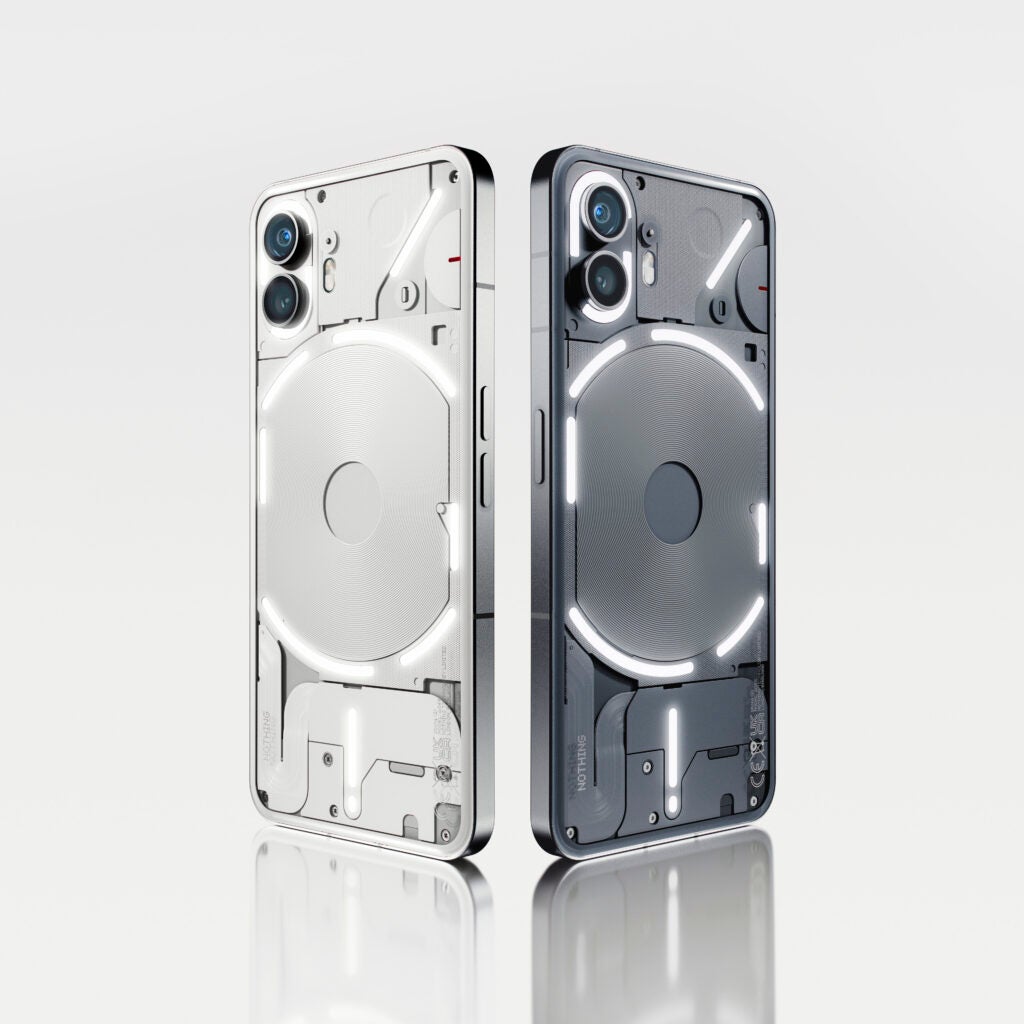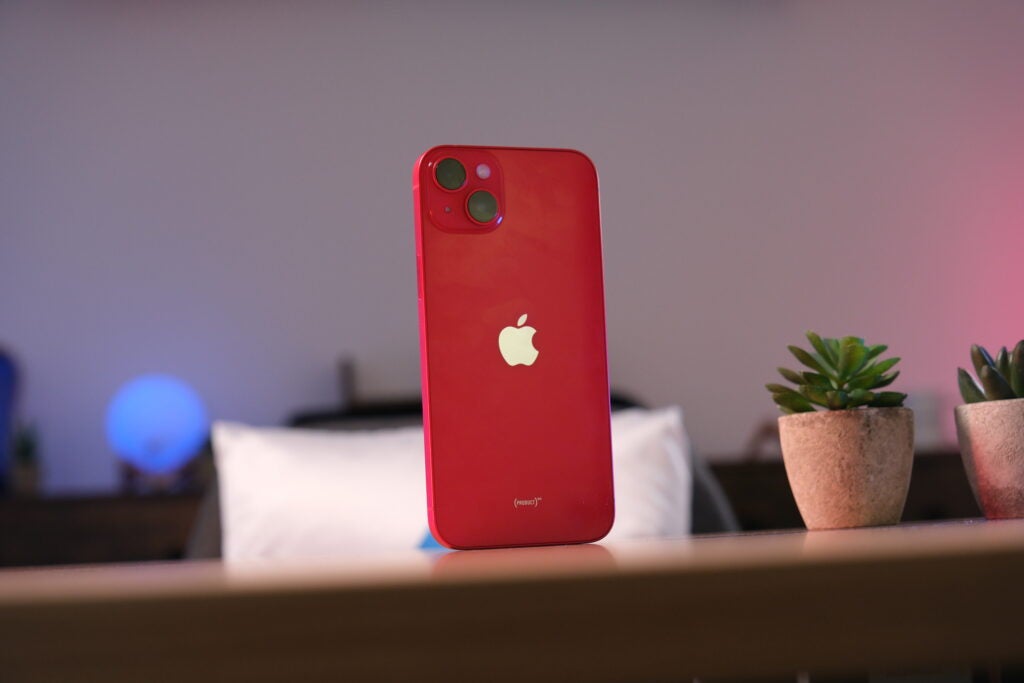Nothing Phone (2) vs iPhone 14: Which is best?

Nothing has just revealed the Nothing Phone (2), boasting improvements to the Glyph Interface, a serious injection of power and better camera capabilities – but how does it compare to the iPhone 14?
Despite the fact that you can get the Nothing Phone (2) for almost £300 less than the iPhone 14, the two phones share more than a few similarities including a similar dual-camera setup, flagship-level power and all-day battery life. The question is, then, which smartphone should you opt for?
We’ve listed five of the key differences between the Nothing Phone (2) and iPhone 14 to help you divide which is best for your needs.
The Nothing Phone (2) has the Glyph Interface
The iPhone 14 has that same distinct design that all iPhones have rocked since the iPhone 12, and while there’s nothing wrong with the design – it’s clean, colourful and feels premium thanks to the use of glass over plastic – the Nothing Phone (2) has a trick up its sleeve in the form of the Glyph Interface.
The feature made its initial debut on the Nothing Phone (1) and the company has improved the functionality in the Nothing Phone (2). While the shapes of the glyphs – essentially LED light strips on the transparent rear – are the same, Nothing has upgraded the LEDs themselves.
This leads to finer control, enabling new features like the ability to display a timer using the glyphs, as well as being able to both go brighter and dimmer than their predecessor.

Gimmicky features aside, the Nothing Phone (2)’s Glyph interface is used in a range of ways, from syncing up with notifications and calls to give you an extra visual alert (especially when your phone is face-down and on vibrate) to being used as a softer fill light than a regular flash when taking photos in low light conditions.
It’s a feature that remains exclusive to the Nothing Phone family, and it’s something we can’t see changing anytime soon. So, if you like the Glyph interface, you’ve only really got one option available.
iOS 14 vs Nothing OS 2.0
One of the biggest differences between the Nothing Phone (2) and the iPhone 14 is the software they run. The iPhone 14 runs Apple’s iOS 16, while the Nothing Phone (2) comes with Android 13 running Nothing’s custom UI, Nothing OS 2.0.
Apple’s iOS operating system is a huge selling point of the iPhone and it’s not hard to see why: the interface is simple to use, there is a huge volume of apps and games available on the App Store and iOS devices tend to play very well with other Apple products like AirPods, iPad and Mac. There are also features like iMessage and Face ID to consider, both of which are exclusive to Apple’s platform.
That’s not to say it’s better than the Nothing OS 2.0 interface though – they’re just totally different. Nothing has taken a heavily stylised visual approach to the Android experience, offering dot-matrix-themed graphics, text and a bunch of Nothing-designed Home screen widgets that suit the theme.

It’s also the only manufacturer to offer support for all apps with its custom iconography, meaning all apps sport the same black-and-white theme regardless of whether they offer support for it or not.
There are also all the software quirks that play into the Glyph interface mentioned above, from notification and call alerts to more niche features like a timer that displays progress on the Glyph interface to the ability to check how much charge your phone has when plugged in.
At this point you’ll likely know which operating system you prefer, so if you’re an iOS fan, your sights should be set on the iPhone 14 while Android fans should opt for the Nothing Phone (2).
The Nothing Phone (2) has higher-res cameras
Both the iPhone 14 and Nothing Phone (2) sport the same combination of a main and ultrawide sensor on their rears, though there is a difference when it comes to megapixel count.
The Nothing Phone (2) comes out on top in terms of the number of pixels on offer with a 50MP main sensor and a 50MP ultrawide – a big jump compared to the dual 12MP offerings of the iPhone 14.
Of course there’s more to camera performance than megapixels but it does give the Nothing Phone (2) to use pixel binning tech that essentially compresses multiple pixels into one to improve both detail and light, which could give the Nothing Phone (2) the edge in certain scenarios – but we’ll have to wait and see how it performs in our full review.
Though it may not be as well equipped as the iPhone 14 Pro, our reviewer felt that the iPhone 14’s camera performance was great, offering a marked improvement in low-light photography, skin tone rendering and improved image processing compared to the iPhone 13, so the Nothing Phone (2) will certainly have its work cut out for it.
The iPhone 14 is (slightly) more powerful
Another area where the Nothing Phone (2) and iPhone 14 differ is in the performance – though not by as much as you might expect given the flagship price tag of the iPhone 14 and its A15 Bionic chipset.
That’s largely down to the inclusion of the (2022 flagship) Snapdragon 8 Plus Gen 1 chipset within the Nothing Phone (2) – a big increase on the Snapdragon 778 Plus 5G of the Nothing Phone (1) – that allows it to better compete with flagship phones, particularly those that launched in 2022 like the iPhone 14.

While we’re yet to benchmark the Nothing Phone (2), we’ve reviewed plenty of Snapdragon 8 Plus Gen 1-equipped phones including the OnePlus 10T, Motorola Razr 40 Ultra and Poco F5 Pro, so we’ve got a good idea of the levels of power on offer from the chipset.
If Nothing’s results align with others we’ve seen, we expect impressive performance and flagship benchmark results, but it likely still won’t beat the A15 Bionic chipset on offer from Apple – and that’s with a boosted 8/12GB of RAM compared to the iPhone 14’s 6GB RAM.
However, with flagship-level power available on both handsets, it’s unlikely that you’ll notice a difference in day-to-day performance.
The Nothing Phone (2) is much cheaper
If you’re still on the fence about whether the Nothing Phone (2) or iPhone 14 is best for your needs, the price may help sway your decision one way or the other.
The iPhone 14 is a pricey flagship smartphone that, while cheaper than the top-end iPhone 14 Pro Max, is still fairly expensive with a starting price of £849 with 128GB of storage. You’ve also got 256GB for £949, and 512GB for an eye-watering £1,179.
The Nothing Phone (2) is considerably cheaper with a starting price of £579 for the 8GB and 128GB combo, going up to £629 for 12GB and 256GB and £699 for the top-end 12GB/512GB combination.
It’s still a bit of a price hike compared to the Nothing Phone (1)’s £399 price tag, but with the improvements – particularly in the performance department – it’s an easier pill to swallow.





